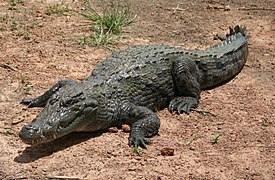For other uses, see Crocodile (disambiguation).
For differences between alligators and crocodiles, see Crocodilia#Differences between alligators and crocodiles.
| Crocodiles Temporal range: 55–0Ma Eocene – Recent | |
|---|---|
 | |
| Nile crocodile (Crocodylus niloticus) | |
 | |
| Estuarine crocodile (Crocodylus porosus) | |
| Scientific classification | |
| Kingdom: | Animalia |
| Phylum: | Chordata |
| Class: | Reptilia |
| Clade: | Crocodylomorpha |
| Order: | Crocodylia |
| Family: | Crocodylidae |
| Subfamily: | Crocodylinae Cuvier, 1807 |
| Type species | |
| Crocodylus niloticus Laurenti, 1768 | |
| Genera | |
| |
 | |
| Worldwide distribution of crocodiles | |
Crocodiles (subfamily Crocodylinae) or true crocodiles are large aquatictetrapods that live throughout the tropics in Africa, Asia, the Americas andAustralia. Crocodylinae, in which all its members are considered true crocodiles, is classified as a biological subfamily. A broader sense of the term crocodile,Crocodylidae, that includes the tomistoma, was excluded in this article since new genetic studies reveal the possibility of tomistoma as a close relative of thegharial.[1] This article applies the term crocodile only to the species within the subfamily of Crocodylinae. The term is sometimes used even more loosely to include all extant members of the order Crocodilia: which includes all members of Crocodylidae, including the tomistoma, the alligators and caimans (familyAlligatoridae) and the gharials (family Gavialidae), and the rest of Crocodylomorpha, which includes all of the prehistoric crocodile relatives and ancestors.
Although they appear to be similar to the untrained eye, crocodiles, alligators and the gharial belong to seperate biological families. The gharial having a narrow snoutis easier to distinguish, while morphological differences are more difficult to spot in crocodiles and alligators. The most obvious external differences are visible in the head with crocodiles having narrower and longer heads, with a more V-shaped than a U-shaped snout compared to alligators and caimans. Another obvious trait is the upper and lower jaws of the crocodiles are the same width, and teeth in the lower jaw fall along the edge or outside the upper jaw when the mouth is closed; therefore all teeth are visible unlike an alligator; which possesses small depressions in the upper jaw where the lower teeth fit into. Also when the crocodile's mouth is closed, the large fourth tooth in the lower jaw fits into a constriction in the upper jaw. For hard-to-distinguish specimens, the protruding tooth is the most reliable feature to define the family, the species belongs to.[2] Crocodiles have more webbing on the toes of the hind feet and can better tolerate saltwater due to specialized salt glandsfor filtering out salt, which are present but non-functioning in alligators. Another trait that separates crocodiles from other crocodilians, are the much higher levels ofaggression.[3] All reptiles are all scaled diapsids, which are divided into two groups: crocodilians are archosaurs, along with birds and the extinct dinosaurs, while other reptiles are lepidosaurs.
Although all crocodiles are anatomically and biologically similar; their size,morphology, behavior and ecology somewhat differs between species. However, they have many similarities in these areas as well. All crocodiles are semiaquaticand tend to congregate in freshwater habitats such as rivers, lakes, wetlands and sometimes in brackish water and saltwater. They are carnivorous animals, feeding mostly on vertebrates such as fish, reptiles, birds and mammals, and sometimes on invertebrates such as molluscs and crustaceans, depending on species and age. All crocodiles are tropical species that unlike alligators, are very sensitive tocold. They first separated from other crocodilians during the Eocene epoch, about 55 million years ago.[4] A lineage, including the rest of Crocodylomorpha, have been around for at least 225 million years, survived multiple mass extinctions, but today, due to habitat destruction and poaching, many species are at the risk of extinction, some being classified as critically endangered.
No comments:
Post a Comment